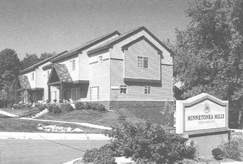Homes located near affordable family rental housing in the Twin Cities displayed strong market performance after the affordable housing properties were built, according to a recent study conducted by Maxfield Research. The same homes had similar or stronger market performance in comparison to those in a control group.
The study, which was funded by the Family Housing Fund of Minneapolis, examined real estate market performance in 12 Twin Cities neighborhoods where tax-credit rental housing developments for families were constructed between 1993 and 1997. The study focused on dense neighborhoods, or subject areas, with 100 or more owner-occupied homes within one to three blocks. Researchers analyzed sales price per square foot, percentage of sales to asking (list) price, and time on the market for the three-year periods before and after the construction of affordable housing in each subject area.

|
Minnetonka Mills in Minnetonka, Minn., is one of the affordable suburban housing developments included in the Family Housing Fund study. Minnetonka Mills is a project of The Cornerstone Group, which develops affordable multifamily housing in the Upper Midwest. For more information, visit www.thecornerstonegroup.com. (Photo © Don Wong/Courtesy the Cornerstone Group) |
Extensive comparisons between the pre- and post-construction periods and between the subject areas and the greater Twin Cities revealed that the price trends for the studied homes were generally upward, with decreased market time and increased sales-to-list price percentages. Homes in subject areas had significantly higher average per-square-foot price appreciation after tax-credit housing was built in the neighborhood, and the subject areas and control markets performed similarly. In only 4 percent of cases did market values in subject areas fall below the range of values in the control group. In nearly all of those cases, the poor market performance lasted for a year and was isolated to a small group of homes.
Based on these findings, researchers concluded that the housing markets in the subject areas performed normally following the construction of affordable housing and that market fluctuations in the areas studied were similar to those in the larger market.
For more information on the Family Housing Fund or to read the full study, visit www.fhfund.org.




